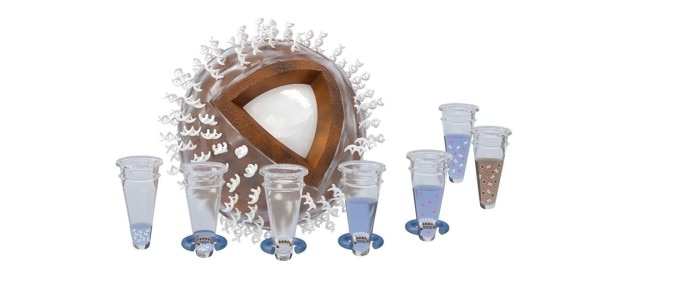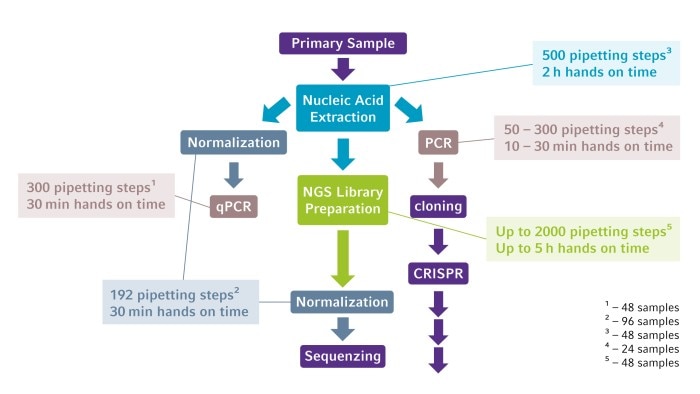MENU
FR | EUR
-
-
-
-
- Services pour bioprocédés
- Services pour centrifugeuse et rotors
- Service pour pipette
- Services pour Mastercycler
- Services pour automates de pipetage
- Services pour congélateurs
- Services pour incubateurs
- Services pour agitateurs
- Services pour appareils de photométrie
- Service de contrôle de la température et de l’agitation
-
-
-
-
-
- Services pour bioprocédés
- Services pour centrifugeuse et rotors
- Service pour pipette
- Services pour Mastercycler
- Services pour automates de pipetage
- Services pour congélateurs
- Services pour incubateurs
- Services pour agitateurs
- Services pour appareils de photométrie
- Service de contrôle de la température et de l’agitation
-
FR | EUR
Aucun résultat trouvé
Chercher des suggestions

NGS library preparation: How protocols using magnetic beads profit massively from automated pipetting
Lab Academy
- Biologie moléculaire
- Postes de manipulation de liquides
- Pipetage et distribution
- Next Generation Sequencing
- Automatisation
- Test
Handling magnetic beads is a critical step within NGS library preparation or nucleic acid purification. There is a lot to be considered that this process does not mutate into a strenuous and error-prone tightrope act. Wouldn't it be nice if there was some relief – topped with an improved precision, accuracy and reproducibility? Read why automated pipetting makes your bead-based cleanup become a walk in the park!
“Bead” It! – What are magnetic beads used for?
The use of magnetic beads is a fast, efficient and convenient method for the extraction and cleanup of nucleic acids from complex mixtures. The beads bind genomic DNA, plasmids, RNA or mitochondrial DNA reversibly and can be safely immobilized and separated by a strong magnet.
The bead-based cleanup convinces with its high yield, excellent purity and affordability. The technique is very “gentle”, because it involves no centrifugation steps that may cause breaking of nucleic acids due to shear forces. Being easy to execute by simply putting a magnet to the vessel, it is easily scalable to sample numbers and volumes – an optimal prerequisite for high-throughput applications. Quite logical, that the bead-based cleanup is part of nearly every NGS library preparation to select a specific fragment size. Also, nucleic acid extraction or purification (NAP) utilizes the advantages of bead-based cleanups.
Up to 2.000 manual pipetting steps!
However, especially when processing large numbers of samples, this technique demands a lot. The laborious procedure burdens you with a tremendous number of pipetting steps in exhaustive long and complex protocols. An NGS library preparation for 48 samples means pipetting up to 2000 x with 5 h hands on time. NAP of 24 samples strikes with 500 x pipetting and 2 h hands-on time.
Do you work manually in 96-well-format? Then you have to cope with small, nearly invisible pellets, especially when located in the center of the plate. What you cannot see, you cannot react to. To deliver the permanent concentration the process requires, you almost need the qualities of a machine. Thus, this manual “Sisyphus work” bears a high susceptibility to errors and a high risk of losing beads.
Bead carryover is another famous manual pipetting issue, as they can interfere with downstream applications. Inter-user and inter-run variabilities as well as liquid transfer with manual pipettes can impair precision, accuracy and reproducibility.
After all, failed experiments are not an option as they lead to loss of valuable sample, reagents, consumables, time and money.
Critical magnetic bead-handling during NGS library prep
The handling of magnetic beads is one of the most critical steps during preparation of a high-quality NGS library. Bead-based cleanups appear several times for removal of impurities, buffer and enzymes from previous enzymatic reactions.
For the recovery of a reproducible DNA fragment size, you have stick meticulously to the bead-to-DNA volume ratio and a thorough bead resuspension. A proper consumable-to-magnet fit during separation is vital for a high-quality cleanup. The magnet has to be strong enough to avoid loss of beads. Optimal ethanol removal is essential for final elution of DNA fragments and to avoid inhibitory effects in downstream reactions. NGS beads in viscous PEG-solution require the right pipetting technique and equipment to be pipetted precisely.
The benefits of an automated bead clean-up
Pipetting robots take all those considerations off your shoulders. What an enormous relief! Magnetic bead-based protocols like NGS library preparation or NAP become a walk in the park:
1. Reduced hands-on time. Complex pipetting-intensive protocols become ready-to-run with minimal interventions. For example: Preparing an NGS library prep out of total RNA requires 2 days manual work of repetitive pipetting and outstandingly high concentration. With an automated liquid handler, you can reduce your hands-on time to something between 30 min and 2 h and as little as 10 to 50 pipetting steps (depending on your sample number and used protocol). For NAP you can reduce your hands-on time down to 10-15 minutes and reduce the manual pipetting steps to a bare minimum for a 2 h run. Imagine what you could do with the time you gained!
Lire moins

Overview of genomic workflows with pipetting steps and hands on time.
2. No more loss of beads or carryover. Concentrated manual “Sisyphus Work” with invisible pellets in tiny wells belongs to the past. Honestly, the pipetting robot can do it better and never gets tired! And you have practically no bead carryover as beads are transferred safe and precisely.
3. Perfect bead handling for NGS-library prep. Your pipetting robot is perfectly equipped and educated for the recovery of a reproducible DNA fragment size. The volume ratio of bead-to-DNA will be kept, beads will be thoroughly resuspended, a strong magnet will recover beads without loss, the proper consumable-to-magnet fit during separation ensures a high-quality cleanup. Ethanol will remove optimally so you avoid inhibitory downstream effects. Beads in PEG-solutions will be pipetted precisely.
4. Pre-optimized bead-based protocols for NGS library prep and NAP. For customization, you can break down complex workflows into single steps with simple commands which you can easily align in the software.
5. Consistent precision and accuracy. No person-to-person and day-to-day variability and no errors associated with manual pipetting keep precision and accuracy and pave the way for reproducible results.
6. Scale your throughput up. Process up to 96 samples with ease and without nervous breakdowns.
7. Improved user safety. Less manual pipetting, less strain on muscles and joints.
A pipetting robot is available in different models. You can choose out of smart benchtop versions up to large high-throughput machines depending on your application spectrum.
The best painter cannot paint with a bad brush! And so, does a pipetting robot. Stability comes first! Warping microtiter plates after heating is an absolute no-go. A perfect fit between vessel and magnet is crucial for NGS to have an optimal purification. Otherwise, the plate has to be exchanged after heating, which means sample loss. Microtiter plates with smallest dead volume minimize liquid loss. Take care that your consumables are clean and leachable-free.
Show me automated liquid handling solutions and consumables from Eppendorf
3. Perfect bead handling for NGS-library prep. Your pipetting robot is perfectly equipped and educated for the recovery of a reproducible DNA fragment size. The volume ratio of bead-to-DNA will be kept, beads will be thoroughly resuspended, a strong magnet will recover beads without loss, the proper consumable-to-magnet fit during separation ensures a high-quality cleanup. Ethanol will remove optimally so you avoid inhibitory downstream effects. Beads in PEG-solutions will be pipetted precisely.
4. Pre-optimized bead-based protocols for NGS library prep and NAP. For customization, you can break down complex workflows into single steps with simple commands which you can easily align in the software.
5. Consistent precision and accuracy. No person-to-person and day-to-day variability and no errors associated with manual pipetting keep precision and accuracy and pave the way for reproducible results.
6. Scale your throughput up. Process up to 96 samples with ease and without nervous breakdowns.
7. Improved user safety. Less manual pipetting, less strain on muscles and joints.
A pipetting robot is available in different models. You can choose out of smart benchtop versions up to large high-throughput machines depending on your application spectrum.
Excellent work needs excellent equipment
The best painter cannot paint with a bad brush! And so, does a pipetting robot. Stability comes first! Warping microtiter plates after heating is an absolute no-go. A perfect fit between vessel and magnet is crucial for NGS to have an optimal purification. Otherwise, the plate has to be exchanged after heating, which means sample loss. Microtiter plates with smallest dead volume minimize liquid loss. Take care that your consumables are clean and leachable-free.
Convinced?
Show me automated liquid handling solutions and consumables from Eppendorf
Lire moins
